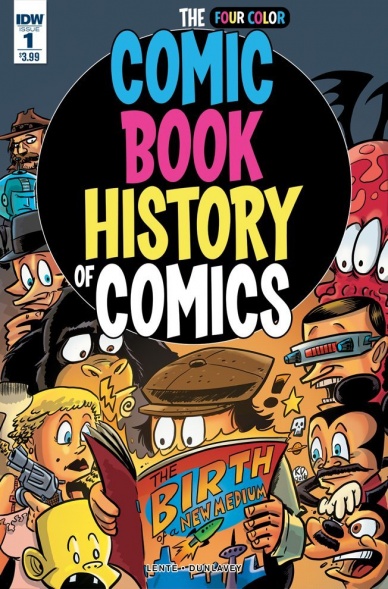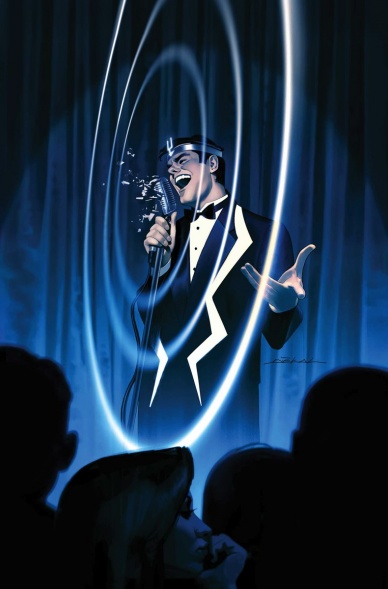There is a lot to cover on Wednesdays. We should know, as collectively, we read an insane amount of comics. Even with a large review staff, it’s hard to get to everything. With that in mind, we’re back with Wrapping Wednesday, where we look at some of the books we missed in what was another great week of comics.
Let’s get this party started.

Comic Book History of Comics #1
Written by Fred van Lente
Illustrated by Ryan Dunlavey
Reviewed by Matthew Garcia
From the creators behind “Action Philosophers” comes “The Comic Book History of Comics” #1, a new, now in color, serializing of their original graphic novel released through IDW using the comic format to explore its legacy. Created by Fred van Lente and Ryan Dunlavey, the focus in this inaugural issue is set at the start of the 20th century, where the first sequential strips were starting to appear in major newspapers and cartoonists found themselves in high demand. (Van Lente and Dunlavey do touch on some of the prehistoric cave drawings and early satirical illustrations, but they are more concerned with comics themselves in this piece.) We get to see the great Winsor McCay blend figure out how to blend animation and live action, then take the concepts to the Sunday pages with innovative breakdowns and presentations. We see Nell Brinkley cover major national events in comics format. Van Lente and Dunlavey make the strongest connections between the fledgeling days of animation and the world of cartooning; two mediums that continue to play off of each other to this day.
Dunlavey uses the page breakdowns themselves to help illustrate his point. There’s a “Little Nemo”-esque page, a Who’s on First gag, and even some sequences that evoke storyboards. Unlike someone such as Scott McCloud, Dunlavey doesn’t use snippets of the material he and van Lente are discussing, but instead tries to match the work in his own style. This ranges from keeping a consistent aesthetic, to a distracting parody (like those box sets of classic songs that sound almost like the original but distractingly not quite), to some truly inspired moments. I’m thinking of when Walt Disney achieves a god-like status and ascends leadership of the page.
“The Comic Book History of Comics” #1 is informative and delightful. Obviously, a lot of research went into bringing this thing to life and van Lente and Dunlavey approach it with confidence and exuberance. It understands how to make us care about this history (by building the narrative around people we recognize) and we’re interested in following their exploits. It also leaves readers with plenty of classic strips they might want to try out.
Final Verdict: 8.0 – It might not be any new information for the most intense aficionados but it offers a charming and accessible story for those interested in anything comic-related.

Green Lanterns #11
Written by Sam Humphries
Illustrated by Robson Rocha
Reviewed by Robbie Pleasant
There’s a new Green Lantern… sort of. The Phantom Ring has found its wielder, and to call him “smarmy” would do him little justice. Robson Rocha must have mastered every form of smirk to possibly draw on a character, and it’s remarkable how big a difference that can make; in many moments, the same dialogue and action presented in a slightly different way, would make Frank a more likable character, but the contrast is the purpose.
The comic does a good job letting us know this new Lantern through both narration and action. It serves to enhance even his moments of actual heroism with a sense of smugness, and self-satisfaction that tips us off that his heart isn’t in as quite the right place as it should be. (Contrast with Guy Gardner, who we know has a good heart in spite of all he does to antagonize his teammates.)
At the same time, the comic’s leading characters, Simon Baz and Jessica Cruz, make a play right out of the “mistakes superheroes make in comics when they need conflict” handbook. Without spoilers, I’ll just say that the two tools that heroes most often forget about are communication and good press. Still, we get a few moments showing how Jessica is starting to stand out as a unique Green Lantern in her own regard, which is essential for any new human GL.
Continued belowWe also get some good escalation of the conflict, showing some cracks in the armor that Frank wears with a smirk, and the effects of the Phantom Ring. So minor issues aside, it carries the story well, and the artwork does a great job at illustrating every scene, framing each dramatic moment, and bringing personality into every expression.
Final Verdict: 6.7 – Good characterization and artwork only slightly hampered by some plot-mandated poor choices. Continues to build the Phantom Ring story arc well.

Reborn #2
Written by Mark Millar
Illustrated by Greg Capullo
Reviewed by Brian Salvatore
“Reborn” #1, an issue I wasn’t expecting to enjoy, really moved me, both through Greg Capullo’s art and Mark Millar’s story about facing down the end of life, and what lay on the other side. It was an incredibly hopeful story, and I was eagerly anticipating the second issue, to begin to lay out a clearer path as to what the series was going to be about.
With the second issue, I’m not really sure I have any better idea than I did a month ago what the overwarching theme is, but I am feeling a lot less certain about the hopeful tone that was set in the first installment.
While it is clear that Golgotha and the evil folks are, well, evil, I have less certainty that the folks that Bonnie finds herself with are as well-intentioned as they appear to be. The fact that Bonnie’s father didn’t know the name of her husband threw up a red flag for me, even if it is unclear if they would have ever met. We know that Harry, her husband, is there as well, as he is the first person we saw in issue #1 crossover into this new world. The search for Harry appears to be, at least initially, what this book is going to be taking us through.
But as I said, the intentions of the ‘good’ guys are never really questioned, even as they, minutes after her arrival, are telling her that she’s the chosen one, and telling her what she needs to do. I don’t doubt that they’re better than the alternative, but I wonder if there isn’t more there than meets the eye.
While last issue gave Greg Capullo a chance to show off both his rooted in reality and his fantastical sides of his artwork, this issue is all fantasy. He gets to draw his own version of Falkor from The NeverEnding Story, Bonnie’s father is sort of every major Asgaardian from “Thor” mixed into one, and on nearly every page, there is a new creature of setting that Capullo has set forth. His work here is strong, with each character we meet appearing lived in and real; you look at his creations and can practically see the backstory behind every line and shading.
I will say, however, that one of the reasons that “Batman” was Capullo’s coming out party as a comics superstar after a few years in the wilderness was his ability to mix the insanity that is Batman with the reality that is Gotham, and that’s missing a bit in this issue. I know I can’t fault him for not drawing a more down to earth afterlife where we are imbued with mystical powers, but I do wish that the book offered him a chance to balance his work better. But when judging the work against itself, the only real way to review a book like this, Capullo is doing some fantastic work, and seems revitalized by playing in a non-Gotham setting for a bit.
Final Verdict: 6.8 – While not as moving or beautiful as last month’s, “Reborn” #2 was an enjoyable step in what looks to be – in this writer’s opinion – the best thing with Millar’s name on it in a long time.

Spell On Wheels #2
Written by Kate Leth
Illustrated by Megan Levens and Marissa Louise
Reviewed by Jess Camacho
The first issue of “Spell On Wheels” was charming in so many ways. It had likable characters, a solid premise and beautiful art. The second issue, however, stumbles a bit but most of this is on the writing. This is a planned miniseries and while the search for the missing items is compelling enough for as single issue, I do wish we knew more about the bigger villain behind all this. I also wasn’t wild about Claire’s portrayal. Their host is a creep but she spends a great deal of time being overbearing and generally ruining the fun her friends are having independent of their creepy host. It ultimately pays off but it does wear thin.
Continued belowLevens and Louise continue to add a level of levity to this series with their wonderful work. Levens’s art is expressive and bursting with style and a fresh perspective. The party scenes full of life and excellently detailed and the magical elements have such a great spirit within them. Louise’s colors are bright and bold and really help to keep “Spell On Wheels” from getting too serious.
Final Verdict: 6.8 – The art is great but the writing left a little to be desired.

Uncanny Inhumans #15
Written by Charles Soule
Illustrated by R.B. Silva
Review by Ken Godberson III
With one war over, but another on the horizon, “Uncanny Inhumans” takes the time it has to tell a story about a loyal soldier of Attilan who fell in the line of duty, the two daughters she left behind, desperate to have their mother back and the price one can pay for messing with the universe. I’m not going to lie, the concept behind this story, titled “A Song of Endings”, reminded me very much of “Fullmetal Alchemist” but replace Edward and Alphonse Elric with Irelle and Treste, the daughters of Auran, who died at the hands of Maximus way back in Charles Soule’s first foray with this property, “Inhuman”. I have to give credit where it is due, Soule has been planting breadcrumbs to this story in the background of bigger events.
Really, this story is a meditation on death in superhero comics, resurrection and just how “real” these characters are. When all we have about these characters are just a collection of scenes we see them in, just how much are they really composed of. The idea becomes much more literal with a character like Reader, who can literally “read” a person back to life. It’s the nice start on discussing a subject in Big 2 comics I’ve always found interesting and aggravating.
R.B. Silva, inker Adriano di Bendetto and colorist Java Tartaglia provide a nice intimate ambiance that works well with The Quiet Room, the Inhuman club/information outpost while being able to emphasize some of the more colorful characters like Flagman. They’re able to quickly go from nightclub intrigue, to quiet and sad moments with Irelle and Treste to downright messing the page format as Reader uses his powers to warp reality. This book has an annoying habit of switch art teams every arc, but this is one of the better ones.
Final Verdict: 8.2- A nice breather arc before “IvX” to contemplate the meaning of death.






